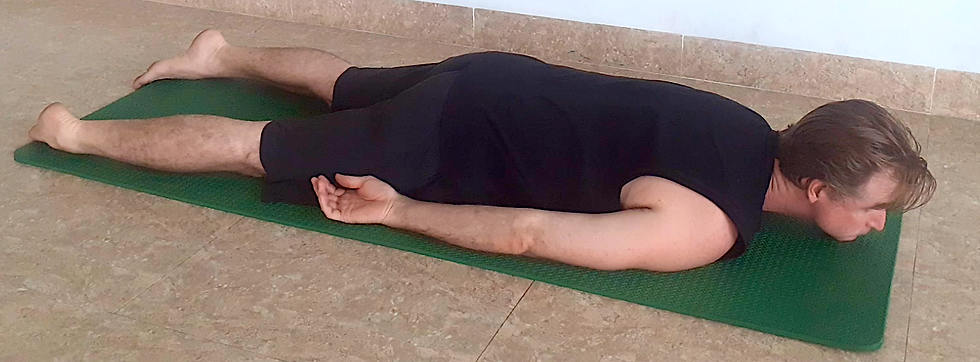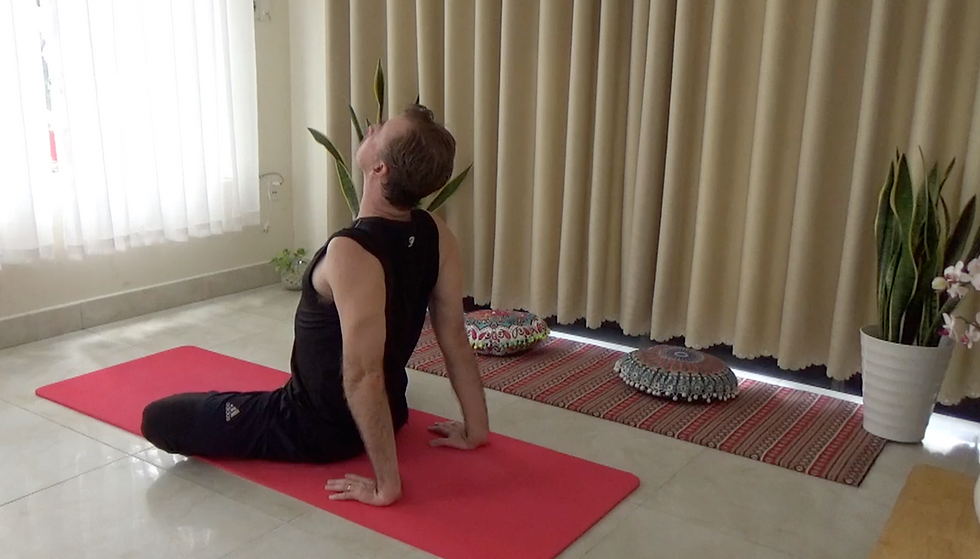Yoga can be very effective for neck pain and there are a variety of poses that can be beneficial. Some of my favorite poses for neck pain are crocodile (makarasana) pose, various backbends, down dog and spinal twists. However, since there are different causes for neck pain, various poses need to be used appropriately. To begin to understand how to get benefits from the asanas, let’s look at some of them individually and in the context of how the neck moves.
One common cause of neck pain these days is that many people spend a lot of time on computers and smartphones, or involved in some kind of work or activity that causes the head and neck to move forward and/or down. When there is excessive flexion and forward movement in the neck it places strain on many of the muscles in the neck, shoulders and upper back.

A good beginning pose to correct this is to lay on your stomach in crocodile pose with your chin on the floor. This causes a gentle extension in the neck that helps to restore the natural curve of the cervical spine. It is a very easy and restful pose. Stay in this position for 5 - 10 slow breaths. Alternately, you may place your hands under your chin and this will lift your head slightly and provide support. The key to the pose is to look forward rather than down. This keeps the neck in extension and corrects chronic flexion in the neck. From this pose we can move in to sphinx, locust, upward dog and bow. This is a nice progression of poses that intensifies the backbends and spinal extensions from prone position. Additionally, the poses in this sequence have similar effects on the neck as they offer the opportunity to place the neck into gentle extensions.

Gentle neck extensions and backbends are useful for many
patterns of neck and upper back pain.
Th cow and camel (ustrasana) poses also place the neck into extension and can help to correct pain due to chronic neck flexion. Cow pose is a great warmup pose and a good place to start if you have chronic neck pain. Typically in yoga we alternate between cow and cat pose and this moves the neck and spine through extension and flexion. Transitioning from cat and cow to downward dog is also good for the neck. (We will talk more about down dog soon).
Seated backbends are also useful for neck and upper back pain.
Notice in the picture below how my neck is in extension and my shoulder blades are moving towards the spine. This posture helps counterbalance the excessive strain that gets placed on the neck and back from sitting and looking into screens. The seated backbend is also a good warm up for the deeper camel pose.

Establishing a good balance between flexion and extension of the neck and spine is a key to getting rid of neck and back pain with yoga.
Neck Pain, Disc Herniations, and Nerve Compression
Another cause of neck pain happens when there is compression on the nerves and discs in the cervical spine. These can result from injuries, aging, and poses like headstands. The small bones (cervical vertebrae) in the neck and spine carry the weight of the head. When the discs between the vertebrae become injured it can cause compression on the nerves and symptoms like neck pain, headaches, numbness and tingling down the arm. For neck pain due to compression in the disc space downward dog can be a good pose.

As down dog is an inversion it decompresses the neck. In down dog the weight of the head gently pulls on the neck and alleviates compression due to gravity and the weight of the head. It is good to do neck movements such as flexion and extension (looking up and down) in down dog, as well as neck rotations by gently turning the head from left to right.
Down Dog also stretches key acupuncture points in the ankles and achilles tendons. These points are used for neck pain in acupuncture and acupressure.

The image above shows the Superficial Back Line (SBL), neck muscles on the SBL, acupuncture points in the achilles tendon, and the urinary bladder (UB) meridian. The SBL is a myofascial line and includes the achilles tendon, calves, hamstrings, erector spinae, and many of the small neck muscles.
Down Dog Stretches the Achilles Tendon and Decompresses the Neck
One reason I like downward dog so much is that it works in a number of ways. We have already spoke about how it can decompress the neck, but it also stretches the achilles tendon. In acupuncture therapy there is a group of points on the achilles tendon that are very effective for treating neck pain, whiplash, and occipital headaches. In downward dog these points get stretched and this can also benefit the neck.
Downward dog is such a great pose for many patterns of neck pain because it works in three ways.
Down dog decompresses the neck
It stretches the achilles tendon and acupuncture points
Allows for therapeutic neck movements with decompression
Watch the Video Below for a Full Demonstration
Movements of the Neck to Consider
The neck has several key movements including looking up and down (extension and flexion), looking left and right (rotations), and lateral bends or tilts (tilting the ear toward the shoulder). When using yoga for neck pain it is important to consider one’s posture and structural alignment. As we discussed many people suffer from chronic flexion in the neck from excessively looking down and forward into screens. Crocodile pose helps to correct this.
For those that have neck pain that results from excessive rotation or tilt to one side, spinal twists and lateral bends are necessary to restore balance. In both rotation and tilt of the neck, the muscles on the side of the neck will be involved. If your head is in chronic rotation or tilts to one side, the muscles on that side will be in chronic contraction. This can cause pain in either side of the neck. To correct these conditions I recommend seated spinal twists and lateral neck bends. Poses like triangle can also be useful as it combines neck rotations with stretches through the lateral line of the body. However, triangle pose can be challenging for some, so for people with intense pain it is best to start with simple spinal twists and lateral head bends and tilts.
For more information about yoga therapy, yoga anatomy, and using acupressure points with yoga visit this link and join my mailing list. Yoga Anatomy and Acupressure
Read more about Pressure Points for Migraines

Comentarios